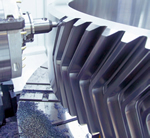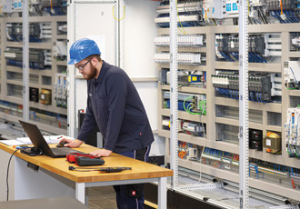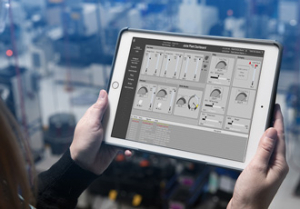SGS tooling stirs up a Vortex for Delcam
20th February 2013
Source:
SGS

Although Delcam is renowned for its advanced CAD/CAM software, the company also operates an extremely well equipped machine shop. Here, the very latest CNC machine tools are pushed to their limits, providing an opportunity to test software developments and machine actual components for customers around the world. While SGS solid carbide cutting tools are used extensively for component machining, they are also raising the benchmark for Delcam’s new cutting strategies.
The
company’s recently refurbished and updated machine shop forms part of Delcam Professional Services, a division of the company that employs around 25 staff providing intellectual services such as consulting and customer software engineering services, as well as an environment for advanced software testing.
Vortex, for which Delcam has a patent pending, has been developed by the company specifically to gain the maximum benefit from solid carbide tooling, in particular those designs that can give deeper cuts by using the full flute length as the cutting surface. It can be used for 2- and 3-axis roughing, 3-plus-2-axis area clearance and for rest machining based on stock models or reference toolpaths.
Like other Delcam roughing strategies, Vortex toolpaths are calculated to give more efficient machining by following the shape of the part and by keeping air moves to a minimum. This is particularly important for rest machining operations.
Nick Hill, Operations Manager, explains: “While developing the Vortex roughing strategy we did some interesting test machining with SGS cutting tools with phenomenal results using an air/oil minimum lubrication coolant mix. Unlike other high-speed roughing techniques that aim to maintain a constant theoretical metal-removal rate, the Vortex strategy produces toolpaths with a controlled engagement angle for the complete operation. This maintains the optimum cutting conditions for the entire toolpath that would normally be possible only for the straight-line moves. As a result, the cutting time will be shorter.”
In parallel with the Vortex strategy the software company’s development engineers were bringing a completely new approach to the CAM process with Machine DNA. With this technology Delcam’s PowerMILL will be the first CAM program that calculates a toolpath with reference to the characteristics of the machine on which it will be run.
“With standard CAM systems, the programmer generates toolpaths in the software, which are output as NC code to be run on the machine tool. For each part, the user has to choose the most efficient method. This will be done by selecting various strategies, starting by removing the bulk of the material and ending up with finishing the detailed model. Within each strategy, various parameters must be set that will determine exactly how the material is to be removed. Typical parameters include feedrate, spindle speed, step over and step down, minimum corner radius and point spacing along the toolpath,” says Nick Hill.
To machine a specific material with a given cutter, a tooling manufacturer will publish a recommended feedrate, spindle speed, step over and step down. However, these figures usually relate to the machining of fairly simple geometry using predominantly straight-line moves. Other parameters, such as corner radius, distance between points and so on, are set according to the user’s experience.
“You run Machine DNA on the machine tool first to establish the parameters for that particular machine and then the Vortex software is applied to the roughing to further reduce cutting times. Both machining strategies aim to provide continuous engagement and we did a number of standard test pieces on our DMG DMU 160P 5-axis machining centre using SGS Z-Carb AP cutting tools,” states Nick Hill.
Unlike conventional end mills, where the cutting teeth entering and exiting the material creates a natural rhythm that results in damaging harmonics, the SGS Z-Carb AP cutting tool range has patented three-stage chatter suppression. Harmonics produce a frequency that resonates through the entire tool, resulting in one of the most damaging forms of cutter wear known as chatter, which also degrades the quality of machined finish.
Z-Carb AP features unequal flute spacing helps to disrupt the rhythmic pattern created by the cutting edge of typical end mills, which helps to suppress the development of damaging harmonics. The patented unequal helix design aids in eliminating the damaging harmonics that occur during typical machining by changing the angle at which each cutting edge enters and exits the material during the milling process.
The rake angle is the main factor that determines the size and shape of the chip, as well as the pressure and temperature of the cutting zone. With the SGS Patented Variable Rake Geometry the Z-Carb AP cutter alters and controls the cutting dynamic to take chatter suppression to a whole new level of advanced productivity.
This works in conjunction with the Vortex toolpaths that have a controlled engagement angle, so tools are never overloaded and therefore achieve the maximum tool life. Shock loading caused by changes in the contact angle is minimised, preventing chipping of the flutes. In addition, the stability of the cutting conditions gives more consistent edge temperatures, so prolonging the life of the tool coating and removing heat damage to the surface of the part. Finally, the ability to use step downs of up to two, or even three times, the tool diameter spreads the tool wear evenly over the cutting surface of the tool, again contributing to longer tool life.
Nick Hill continues: “We had Steve Neale, the area sales engineer for SGS, in the machine shop for a few days. His experience provided us with the starting point for testing both the software and the cutting tool’s performance. In CSM3 mould steel at 33 HRc we ramped down 24mm to engage most of the flute and set a step over at 10 per cent, with a feed per tooth of 0.1mm at a surface speed of 110m/min. We kept pushing and ended up running 140m/min with 0.19mm per tooth engaged, way beyond what was recommended. It nearly doubled the machining efficiency, and I think we could have pushed it some more had we wanted to.”
As well as testing and evaluating its software developments, Delcam’s machine shop provides prototype and subcontract production support for companies across the globe. Some customers will specify the cutting tools to be used, while others have calculated a machining time limit. Delcam’s engineers work towards these goals, review the application and work out the best tools for the job, pulling together the best possible package for the customer.
Nick Hill says: “We prefer to deal with all our suppliers directly as it maintains the relationship with the knowledgeable engineers. For solid carbide cutting tools, we tend to use SGS products more than any others. We have a good relationship with the staff, the price is good and the company provides a great service.”
SGS standard high performance S-Carb cutting tools are used for machining aluminium, while Z-Carb AP tools are used on more exotic materials such as titanium and Inconel. Although SGS offers standard solid carbide cutting tools up to 25mm diameter, Delcam does not go above 16mm diameter, and holds an extensive stock of all the common sizes it uses such as 8, 10 and 12mm diameter tools. All cutting tools for ferrous materials are coated, while tools for machining aluminium can be supplied either coated or non-coated.
As you might expect for an advanced machine shop providing prototype production services, the CNC machines are frequently turned over to the machining of composite materials. “We use a lot of composite cutting tools from SGS, including the Series 20 CCR routers and diamond coated tools for finishing operations,” says Nick Hill.
He concludes: “SGS has definitely delivered so far for Delcam, with very reliable products and great service. I know that the company has invested a lot of money in its new facilities in the UK, and is investing heavily in the production of special tools, which we eagerly await the opportunity to try out as well.”
Vortex, for which Delcam has a patent pending, has been developed by the company specifically to gain the maximum benefit from solid carbide tooling, in particular those designs that can give deeper cuts by using the full flute length as the cutting surface. It can be used for 2- and 3-axis roughing, 3-plus-2-axis area clearance and for rest machining based on stock models or reference toolpaths.
Like other Delcam roughing strategies, Vortex toolpaths are calculated to give more efficient machining by following the shape of the part and by keeping air moves to a minimum. This is particularly important for rest machining operations.
Nick Hill, Operations Manager, explains: “While developing the Vortex roughing strategy we did some interesting test machining with SGS cutting tools with phenomenal results using an air/oil minimum lubrication coolant mix. Unlike other high-speed roughing techniques that aim to maintain a constant theoretical metal-removal rate, the Vortex strategy produces toolpaths with a controlled engagement angle for the complete operation. This maintains the optimum cutting conditions for the entire toolpath that would normally be possible only for the straight-line moves. As a result, the cutting time will be shorter.”
In parallel with the Vortex strategy the software company’s development engineers were bringing a completely new approach to the CAM process with Machine DNA. With this technology Delcam’s PowerMILL will be the first CAM program that calculates a toolpath with reference to the characteristics of the machine on which it will be run.
“With standard CAM systems, the programmer generates toolpaths in the software, which are output as NC code to be run on the machine tool. For each part, the user has to choose the most efficient method. This will be done by selecting various strategies, starting by removing the bulk of the material and ending up with finishing the detailed model. Within each strategy, various parameters must be set that will determine exactly how the material is to be removed. Typical parameters include feedrate, spindle speed, step over and step down, minimum corner radius and point spacing along the toolpath,” says Nick Hill.
To machine a specific material with a given cutter, a tooling manufacturer will publish a recommended feedrate, spindle speed, step over and step down. However, these figures usually relate to the machining of fairly simple geometry using predominantly straight-line moves. Other parameters, such as corner radius, distance between points and so on, are set according to the user’s experience.
“You run Machine DNA on the machine tool first to establish the parameters for that particular machine and then the Vortex software is applied to the roughing to further reduce cutting times. Both machining strategies aim to provide continuous engagement and we did a number of standard test pieces on our DMG DMU 160P 5-axis machining centre using SGS Z-Carb AP cutting tools,” states Nick Hill.
Unlike conventional end mills, where the cutting teeth entering and exiting the material creates a natural rhythm that results in damaging harmonics, the SGS Z-Carb AP cutting tool range has patented three-stage chatter suppression. Harmonics produce a frequency that resonates through the entire tool, resulting in one of the most damaging forms of cutter wear known as chatter, which also degrades the quality of machined finish.
Z-Carb AP features unequal flute spacing helps to disrupt the rhythmic pattern created by the cutting edge of typical end mills, which helps to suppress the development of damaging harmonics. The patented unequal helix design aids in eliminating the damaging harmonics that occur during typical machining by changing the angle at which each cutting edge enters and exits the material during the milling process.
The rake angle is the main factor that determines the size and shape of the chip, as well as the pressure and temperature of the cutting zone. With the SGS Patented Variable Rake Geometry the Z-Carb AP cutter alters and controls the cutting dynamic to take chatter suppression to a whole new level of advanced productivity.
This works in conjunction with the Vortex toolpaths that have a controlled engagement angle, so tools are never overloaded and therefore achieve the maximum tool life. Shock loading caused by changes in the contact angle is minimised, preventing chipping of the flutes. In addition, the stability of the cutting conditions gives more consistent edge temperatures, so prolonging the life of the tool coating and removing heat damage to the surface of the part. Finally, the ability to use step downs of up to two, or even three times, the tool diameter spreads the tool wear evenly over the cutting surface of the tool, again contributing to longer tool life.
Nick Hill continues: “We had Steve Neale, the area sales engineer for SGS, in the machine shop for a few days. His experience provided us with the starting point for testing both the software and the cutting tool’s performance. In CSM3 mould steel at 33 HRc we ramped down 24mm to engage most of the flute and set a step over at 10 per cent, with a feed per tooth of 0.1mm at a surface speed of 110m/min. We kept pushing and ended up running 140m/min with 0.19mm per tooth engaged, way beyond what was recommended. It nearly doubled the machining efficiency, and I think we could have pushed it some more had we wanted to.”
As well as testing and evaluating its software developments, Delcam’s machine shop provides prototype and subcontract production support for companies across the globe. Some customers will specify the cutting tools to be used, while others have calculated a machining time limit. Delcam’s engineers work towards these goals, review the application and work out the best tools for the job, pulling together the best possible package for the customer.
Nick Hill says: “We prefer to deal with all our suppliers directly as it maintains the relationship with the knowledgeable engineers. For solid carbide cutting tools, we tend to use SGS products more than any others. We have a good relationship with the staff, the price is good and the company provides a great service.”
SGS standard high performance S-Carb cutting tools are used for machining aluminium, while Z-Carb AP tools are used on more exotic materials such as titanium and Inconel. Although SGS offers standard solid carbide cutting tools up to 25mm diameter, Delcam does not go above 16mm diameter, and holds an extensive stock of all the common sizes it uses such as 8, 10 and 12mm diameter tools. All cutting tools for ferrous materials are coated, while tools for machining aluminium can be supplied either coated or non-coated.
As you might expect for an advanced machine shop providing prototype production services, the CNC machines are frequently turned over to the machining of composite materials. “We use a lot of composite cutting tools from SGS, including the Series 20 CCR routers and diamond coated tools for finishing operations,” says Nick Hill.
He concludes: “SGS has definitely delivered so far for Delcam, with very reliable products and great service. I know that the company has invested a lot of money in its new facilities in the UK, and is investing heavily in the production of special tools, which we eagerly await the opportunity to try out as well.”
Similar articles
More from SGS
- ISO standards for non-electrical equipment in explosive atmospheres 31st July 2018
- SGS Tool Europe to launch Z-Carb HPR at EMO Milan 19th August 2015
- SGS, Edgecam and DMG-Mori highlight Advanced machining capabilities 9th April 2015
- SGS Tool Europe bolsters its UK manufacturing with the appointment of Hugh Welch 12th March 2015
Product Centre Updates
2024 World Battery & Energy Storage Industry Expo (WBE)
8th August 2024
China 1st and 2nd Floor, Area A, China Import and Export Fair Complex




 technology at Jacobs Vehicle Systems.JPG)







Write a comment
No comments